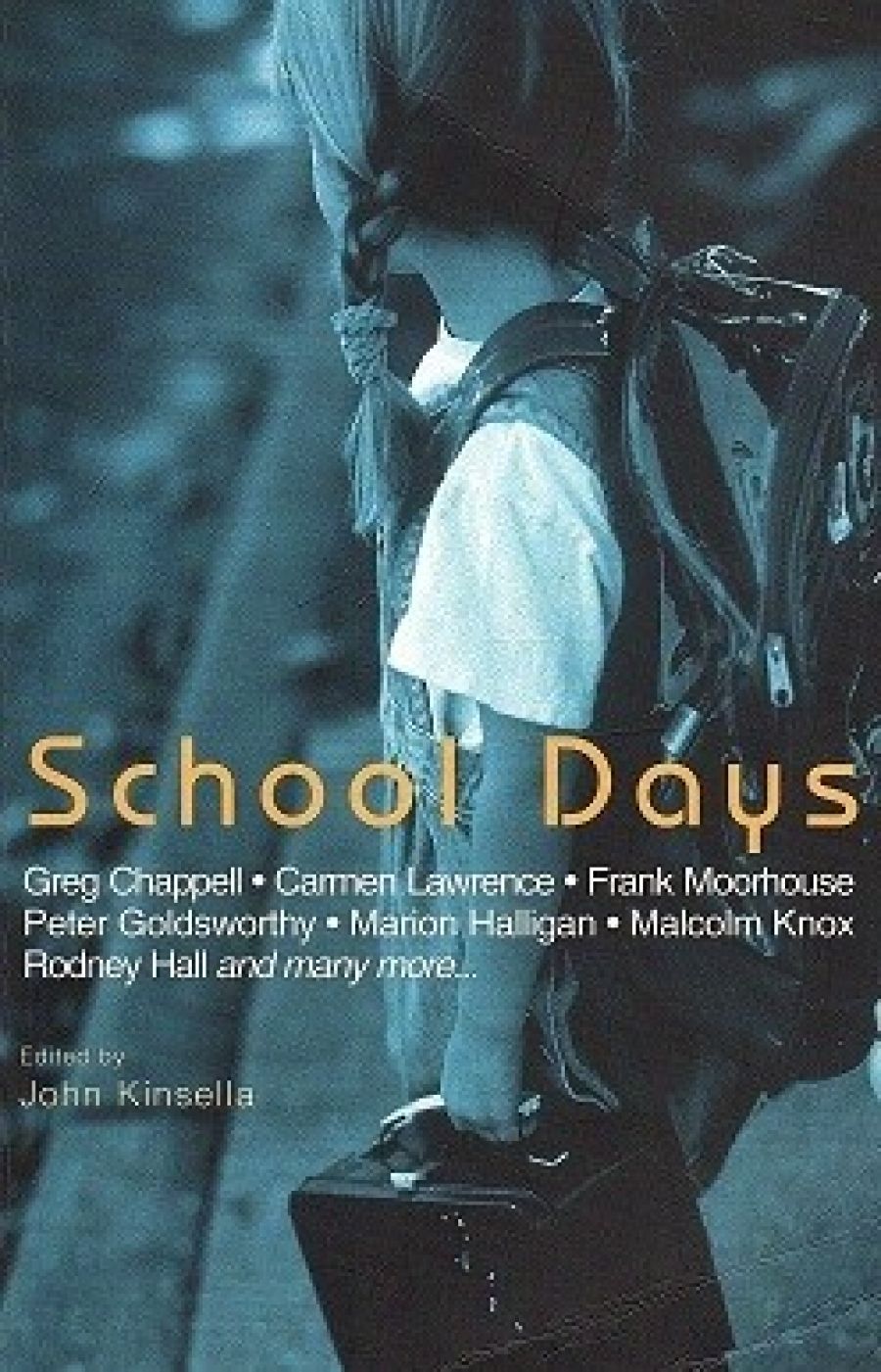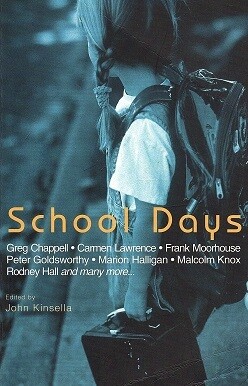
- Free Article: No
- Custom Article Title: The missing host
- Review Article: Yes
- Article Title: The missing host
- Online Only: No
- Custom Highlight Text:
Hands up those who know where Upper Ulam is. In what Melbourne convent school was Veronica Brady’s spiritual and aesthetic education nourished? Can anyone name Eva Sallis’s latest work of fiction or identify the school, somewhere outside Adelaide, where Sallis practised the violin and took her turn at milking the cow?
- Book 1 Title: School Days
- Book 1 Biblio: FACP, $24.95 pb, 239 pp, 1921064714
- Book 1 Cover Small (400 x 600):

- Book 1 Cover (800 x 1200):

These and many other questions were prompted by reading School Days, a collection of essays by twenty-six people whom poet John Kinsella invited to write about their experience of school. I needed Google to show me Upper Ulam, in Central Queensland, where Merv Lilley went to school, but most of the basic facts of time and place for the other contributors were found, or could be guessed at, within their own text. No thanks, however, to Kinsella, the almost invisible editor. With a few lines before each entry, he could have given a brief biographical note, identified the school, placed it on the map and added the relevant dates.
This discontent doesn’t come from any special rage for order, but I do have an interest to declare. When Ian Britain and I co-edited The Oxford Book of Australian Schooldays (1997), we chose a chronological arrangement within which readers, given the context of time and place, could compare two centuries of school experiences. We thought about the method used in The Oxford Book of Schooldays (1994), whose editor, Patricia Craig, chose thematic groupings of short extracts which focus on teachers, school customs, social mobility, sport and other matters in Britain’s schools from the sixteenth century to the present day. Both the British and the Australian anthologies depend almost entirely on previously published material.
Kinsella began by choosing his contributors and asking them to look back at their schooldays in the light of their subsequent histories. Nothing wrong with that as a strategy, but the result is uneven, sometimes bland and, as a collection, lacking in balance and focus. In the twenty-six stories, all but one concerned with schooling in Australia, the arts are disproportionately represented, with writers and musicians taking eighteen places. A judge, two politicians, a child psychiatrist, a barrister, a farmer, a cabinet maker and a cricketer complete a rather haphazardly assembled group. Most are in mid or late career. Between Merv Lilley, writer (b.1919) and Matthew Orlovich, musician (b.1970) there are some celebrated names, others less well known. Those born between the wars include Peter Porter, Peter Sculthorpe, Rodney Hall and Veronica Brady, all children of the Great Depression. Among the postwar baby boomers are Carmen Lawrence and Julian Burnside.
It is no bad thing to give preference to the smaller states, and the representation of indigenous experience is welcome, but Western Australia’s share of the total (seven, not counting Kinsella) seems too generous to the editor’s home ground. Kinsella says that he looked for people whose adult lives interested him. That’s his privilege. But his signpost to a collective meaning is vague and confusingly phrased:
They might have gone to different schools, in different places, come from different generations and different cultural backgrounds, but how did schooling link them? Was the school experience collectively greater than the sum of its parts?
Readers probably do best to forget Kinsella’s unanswered questions and to take the essays as they come. The ordering is quirky: why start with Greg Chappell’s tribute to a former teacher? And yet, why not? There doesn’t seem any method in an arrangement that places the oldest contributor, Merv Lilley, near the end, and that, for no special reason, includes Chinese poet Ouyang Yu in an otherwise all-Australian group. And in a collection of more or less well-wrought pieces by well-known Australians, an ‘as told to’ piece about a rural West Australian schooling from Kinsella’s uncle by marriage, Robert Wheeler, seems a whimsical choice. It does, however, show the vividness of the unrehearsed spoken word. Match it with Greg Chappell’s rather mechanical performance – suitable for a guest appearance at a school prize-giving – and many readers might prefer the unknown Wheeler to the celebrity sportsman. So far as I can see, only Frank Moorhouse’s contribution was previously published. The only work of fiction – or at least the only one which identifies itself as fiction – it plays with ideas of narrative symmetry, and doesn’t enter into conversation with its more direct first-person neighbors.
With so many professional writers at work, it’s no surprise to find some very engaging pieces. Some have looked to their schooldays for the wellspring of later achievement or the shaping of belief. Peter Porter looks back and finds a blank; he neither thanks nor blames his schooling for his life as a poet and the struggle to find his way. Marion Halligan, by contrast, is grateful for the gift of ‘so many of the words that are a natural part of my own thinking’. Veronica Brady remembers an exhilarating world of music and poetry and mystery: an education that was ‘not only metaphysical but ethical’.
For Melissa Lucashenko, an Aboriginal child in a Brisbane primary school in the 1970s, the great lesson was her own powerlessness. ‘Never say no to white people’ stemmed from family memories of stolen children, but was reinforced by school discipline. Aboriginal activist Sam Wagan Watson remembers the ‘nobility’ of some teachers at Mount Gravatt High School in the 1960s, whose influence he weighed against the ignorance and racial hatred he found elsewhere. His main lessons, like Lucashenko’s, came from home and family.
In a mixed bag of memories, two stood out for me, perhaps partly because I had no preconceptions as to how barrister Julian Burnside and ALP politician Carmen Lawrence would see their younger selves, but also because they are written with an engaging freshness, as if the authors are making discoveries as they write. Carmen Lawrence’s convent boarding school, near Geraldton, is evoked in sharply observed detail. She contrasts the barefoot freedom of her farming family life with the regimentation of ‘shoes and queues, silences and prayers’, the glory of Gregorian chant and the loneliness of the long dormitory. Her main lesson? Self-reliance.
Burnside’s twelve years at Melbourne Grammar in the 1950s and 1960s were mostly bleak, in spite of good teaching. He confronts a younger self in whom a sense of inadequacy and a strong wish to achieve were held in tension. A crucial moment, at once trivial and powerfully felt, was the injustice of having a glittering prize arbitrarily withheld, though fully earned. From that, he believes, may stem the concern for justice which is central to his legal career and his place in public debate. Perhaps everyone knows Burnside as a formidable figure and a brilliant speaker in support of the rights of asylum seekers, but it is one more cause for complaint against Kinsella’s refusal to do the editor’s job that the only identification is ‘Julian Burnside QC, barrister’. Similarly, Rachel Siewert is identified only as ‘Senator’. Read her lively piece and you will find that in 1972 her fifth-grade art class was painting ‘It’s Time’ banners, and that she is now Western Australia’s only senator for the Greens. It is good to be introduced to Rachel Siewert and others, but the overall feeling of this anthology is rather like being at a party with lots of interesting people and a missing host.


Comments powered by CComment